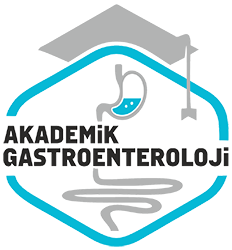Aralik 2021
Endoskopik incelemede saptanan mide poliplerinin yerlesimi, histopatolojik tipleri ve tedavi yönetimi
Location, histopathological types, and treatment management of gastric polyps discovered during endoscopic examination
- Ana Sayfa
- Sayılar
- Aralik 2021
- Endoskopik incelemede saptanan mide poliplerinin yerlesimi, histopatolojik tipleri ve tedavi yönetimi...
Özet
Giriş ve Amaç: Gastrik polip lümene dogru çikinti olusturan, mukozaveya submukozadan köken alan sesil ya da sapli lezyonlar olarak tanımlanir. Bu çalışmanın amacı, gastroskopi islemi sırasında tespit edilenpoliplerin görülme sikliginin, gastrik polip saptanan Hastaların demografik özelliklerinin, poliplerin endoskopik ve histopatolojik özelliklerinin,eslik eden diğer endoskopik bulgularin ve tedavi şekillerinin değerlendirilmesidir. Gereç ve Yöntem: Bu çalışmaya, Haziran 2017 ile Haziran2020 tarihleri arasında üniversite hastanemiz gastroenteroloji bölümüendoskopi ünitesinde yapılan 13280 gastroskopi isleminde, polip saptanan 80 hasta dahil edildi. Seksen hastada toplam 125 polip saptandive retrospektif olarak değerlendirildi. Hastaların yaşi ve cinsiyeti, gastroskopi yapilma nedeni, polip sayisi, poliplerin midedeki lokalizasyonu,polipektomi yöntemi, polip histopatolojisi, Helicobacter pylori pozitifliği,intestinal metaplazi varligi, atrofik gastrit varligi, polipektomi sonrasikomplikasyon gelisip gelismedigi tarandi. Bulgular: Seksen (%0.6) hasta ve bu hastalarda saptanan toplam 125 polip sonucu değerlendirildi. Hastaların 54’ü (%67.5) kadın ve yaş ortalaması 57.5 ± 12.5 yıldi.Hastaların %51.2’sinde endoskopi yapilma nedeni, baska merkezlerdenklinigimize polipektomi amacıyla yönlendirilmeleriydi. Mide mukozaörneklemesinde Hastaların %11.3’ünde Helicobacter pylori pozitifliği,%20’sinde intestinal metaplazi, %21.2’sinde atrofik gastrit mevcuttu.Poliplerin %65.6’sında polip boyutu 10 mm’nin altındaydi. Polipler si-rasiyla; En sık korpusta (%54.4), antrumda (%22.4) ve fundusta (%20.8) saptandi. Poliplerin histopatolojisi En sık fundik gland polip (%42.4),hiperplastik polip (%30.4) ve nöroendokrin tümördü (%20.8). En sıkuygulanan polipektomi yöntemi poliplerin %51.2’sinde biyopsi forsepsiile polipektomidir. Hastaların 5’inde (%4) polipektomi komplikasyonuolarak postpolipektomi interprosedürel kanama gelisti. Sonuç: Çalis-mamizda mide polip saptanma orani literatür ile uyumlu bulunmustur.Endoskopik olarak bazen poliplerin birbirinden ayirt edilmesi zor olabildiginden mümkün olan her polibe güvenli bir şekilde polipektomi yapilmali ve komsu mide mukozasindan örnekler alinmalidir
Abstract
Background and Aims: Gastric polyps are sessile or pedunculated lesions originating from the mucosa or submucosa that protrude into thelumen. We sought to assess the occurrence of polyps discovered duringgastroscopy, the demographic characteristics of patients with gastricpolyps, the endoscopic and histopathological characteristics of polyps,other endoscopic observations, and treatment modalities. Materialsand Methods: We included 80 patients who were found to have polyps during 13,280 gastroscopy procedures conducted in the endoscopy unit of the gastroenterology department of our university hospitalbetween June 2017 and June 2020. After discovering 125 polyps, the80 patients were examined retrospectively. We recorded the age andgender of the patients, reason for gastroscopy, number of polyps, localization of the polyps, polypectomy method, polyp histopathology, Helicobacter pylori positivity, presence of intestinal metaplasia, presence ofatrophic gastritis, and presence or absence of complications after polypectomy. Results: We evaluated 80 out of 125 polyps (0.6%) found inthese patients. Fifty-four (67.5%) patients were women and the meanage was 57.5 ± 12.5 years. Most patients (51.2%) were referred fromother centers for polypectomy. According to the gastric mucosa sampling, 11.3% of the patients had positive Helicobacter pylori, 20% hadintestinal metaplasia, and 21.2% had atrophic gastritis. The size of thepolyp was less than 10 mm in 65.6% of the cases. Furthermore, polypswere most commonly found in the corpus (54.4%), antrum (22.4%),and fundus (20.8%). The most common histopathology of polyps werefundic gland polyps (42.4%), hyperplastic polyps (30.4%), and neuroendocrine tumors (20.8%). Polypectomy with biopsy forceps was themost common polypectomy method used (51.2%). Post polypectomyinterprocedural bleeding occurred as a complication of polypectomyin 5 (4%) patients. Conclusion: The rate of gastric polyp discovery inour study was consistent with that in the literature. Because polypscan sometimes be difficult to distinguish endoscopically, polypectomycan be safely performed for any possible polyp and samples should betaken from the adjacent gastric mucosa



